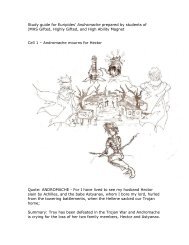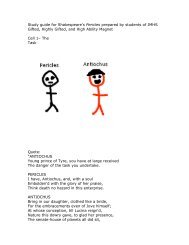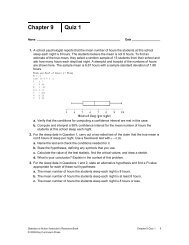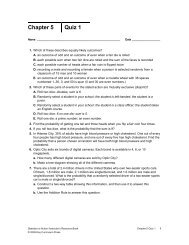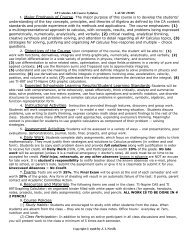- Page 1 and 2:
Study guide for The Taming of the S
- Page 4 and 5:
Cell IV: Sly, Servant and Lord Talk
- Page 6 and 7:
Cell 1: Scene I, Act I. Padua. A pu
- Page 8 and 9:
Cell 3: Scene I, Act I. Padua. A pu
- Page 10 and 11:
Cell 5: Scene I, Act I. Padua. A pu
- Page 12 and 13:
Consider the following sentence fro
- Page 14 and 15:
Cell IIPetruchio: Such wind as scat
- Page 16 and 17:
Cell IIIPetruchio: Signior Hortensi
- Page 18 and 19:
Cell IVHortensio: Petruchio, since
- Page 20:
Cell VHortensio: Her father is Bapt
- Page 23 and 24:
D) WaitWhy do you think Baptista Mi
- Page 25 and 26:
Will Bianca be infuriated when she
- Page 27 and 28:
If Gremio is in love with Bianca, w
- Page 29:
But will you woo her?A) But will yo
- Page 32 and 33:
The taming of the Shrew Scene 1 Cel
- Page 35 and 36:
The taming of the shrew Scene 2Cell
- Page 37 and 38:
The taming of the shrew Scene 2Cell
- Page 39:
B) Insipid, staleC) Foolish, idioti
- Page 42 and 43:
Act I. Scene I. Padua. A public pla
- Page 44 and 45:
Act I. Scene I. Padua. A public pla
- Page 46 and 47:
Act I. Scene I. Padua. A public pla
- Page 48 and 49:
Act I. Scene I. Padua. A public pla
- Page 50 and 51:
Act I. Scene I. Padua. A public pla
- Page 52 and 53:
Act I. Scene I. Padua. A public pla
- Page 54 and 55:
Act I. Scene II. Padua. Before Hort
- Page 56 and 57:
Act I. Scene ii“Petruchio pulls G
- Page 58 and 59:
Act I. Scene ii“Argument”Quote:
- Page 60 and 61:
GQ: Hortensio- Tarry, Petruchio, I
- Page 62 and 63:
Act I. Scene ii “She needs to be
- Page 64 and 65:
Taming Of The Shrew Act 2, Scene 1C
- Page 66 and 67:
Cell 2: Katharina Knows“BAPTISTAW
- Page 68 and 69:
Cell 3: Patricia Enters“PETRUCHIO
- Page 70 and 71:
Cell 4: What’s your name Again?
- Page 72 and 73:
BAPTISTAA mighty man of Pisa; by re
- Page 74 and 75:
Do you think that Katharina will be
- Page 76 and 77:
In the quote above the word mildnes
- Page 78 and 79:
a)Ouch, you hit me!b)You hit that t
- Page 80 and 81:
iii) cutiv) killDo you think that i
- Page 82 and 83:
Katharina is telling Petruchio that
- Page 84 and 85:
iv) money given to the government b
- Page 86 and 87:
Consider the following sentence fro
- Page 88 and 89:
Is it right for Patricia to love a
- Page 90 and 91:
Do you think that Patricia will mak
- Page 92 and 93:
c) personificationd) simileConsider
- Page 94 and 95:
In the following line, when Baptist
- Page 96 and 97:
What do these items make part of?In
- Page 98 and 99:
Consider the following line from th
- Page 100 and 101:
a) nob) a horse soundc) notd) neith
- Page 102 and 103: In the quote above, the word cavil
- Page 104 and 105: children; but in this case of wooin
- Page 106 and 107: ACT III, CELL 2BiancaWhy, gentleman
- Page 108 and 109: Cell 4I must believe my master; els
- Page 110 and 111: Cell # 6(To Tranio) Signior Lucenti
- Page 112 and 113: Cell #7No shame but mine: I must fo
- Page 114 and 115: Cell #9O, sir, his lackey, for all
- Page 116 and 117: Cell #11Tedious it were to tell, an
- Page 118 and 119: d) He’s crazy to dress like that.
- Page 120 and 121: Cell #14I must away to-day, before
- Page 122 and 123: Cell #15They shall go forward, Kate
- Page 124 and 125: Cell 1: Hot Shrew?Quote:Curtis:Is s
- Page 126 and 127: Cell 2: Slow KnavesQuote:Petruchio:
- Page 128 and 129: Cell 4: Burnt MuttonQuote:Petruchio
- Page 130 and 131: Cell 5: Katharina Realizing Somethi
- Page 132 and 133: Consider the following sentence fro
- Page 134 and 135: D. It was your entire fault for thi
- Page 136 and 137: A. Among the gods is Vincentio?B. D
- Page 138 and 139: Cell 10: Hortensio Reveals True Ide
- Page 140 and 141: Cell 11: No Love for HortensioQuote
- Page 142 and 143: Cell 12: Marrying a Wealthy WidowQu
- Page 144 and 145: Cell 13: Petruchio - Master at Tami
- Page 146 and 147: Cell 14 - The shrew is hungryQuote:
- Page 148 and 149: Cell 16 - Shrew FoodQuote: I cannot
- Page 150 and 151: Cell 18 - Impressing the shrewQuote
- Page 154 and 155: Act V. Scene I. Padua. Before Lucen
- Page 156 and 157: Act V. Scene I. Padua. Before Lucen
- Page 158 and 159: Act V. Scene I. Padua. Before Lucen
- Page 160 and 161: Act V. Scene I. Padua. Before Lucen
- Page 162 and 163: Cell 6 Act V; Scene IIWELCOLucentio
- Page 164 and 165: d) absolutism• Who is supposedly
- Page 166 and 167: • Do you think Katharina will get
- Page 168 and 169: Cell 10: Act v; Scene IIComeCOMING
- Page 170 and 171: Cell 11- Biondello enters -Act V, S
- Page 172 and 173: Cell 12- Petruchio and Hortensio ta
- Page 174 and 175: Cell 14- Katharina appears - Act V,
- Page 176: . It is fantastic, if I may say, th





